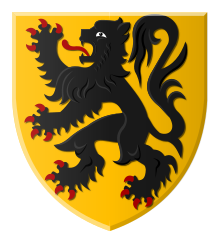Coat of arms of Flanders

The arms of the Flemish Community are: Or, a lion rampant sable, armed and langued gules. Although the lion has been in use for almost nine hundred years as the arms of the Count of Flanders, it only became the official symbol of the Flemish Community in 1973. At present its form and use is subject to the Decree of 7 November 1990.
Origin of the arms
The Flemish lion derives from the arms of the
When the county of Flanders was inherited by the
In 1816 the Flemish lion became part of the coats of arms of the modern Belgian provinces of East Flanders and West Flanders that administer most of the territory of the former county.
It is the inverse of the arms of Brabant, which are a gold lion on a black field.
Symbol of the Flemish Movement
Like many other nationalist movements, the Flemish movement sought and appropriated historical symbols as an instrument for rallying support. The choice of the Flemish lion was primarily based on the popular historical novel De leeuw van Vlaanderen (1838) of
Symbol of the Flemish Community
After gaining
Controversy over the claws
There is discussion within the Flemish movement whether the tongue and claws of the Flemish lion should be red or black. This controversy originated when part of the Flemish movement started to take an increasingly anti-Belgian stand after the First World War. The radicalized resented that the colours of the Flemish lion echoed those of the Belgian flag and therefore propagated a black lion with black tongue and claws. The divide has remained ever since. Officially and historically the Flemish lion should have a red tongue and claws, and while both flags used to be more or less interchangeable until 1973 the entirely black lion has come to stand for the separatist or otherwise radical sections of Flemish nationalism in the eyes of many.[citation needed]
References
- ^ "Vlaamse leeuw" (in Dutch). Archived from the original on November 11, 2018. Retrieved October 17, 2018.
- ^ "NEVB - Vlaamse Leeuw" (in Dutch). Archived from the original on October 18, 2018. Retrieved October 17, 2018.
Bibliography
- Ernest Warlop. Oude Vlaenderen en de zwarte leeuw op gouden veld, Miscellanea archivistica, 28 (1980) 5-52.
- Lieve Viaene and Ernest Warlop. Gemeentewapens in België: Vlaanderen en Brussel (Brussel, 2002) 1: 67–69.
- Hubert de Vries. Wapens van de Nederlanden: De historische ontwikkeling van de heraldische symbolen van Nederlanden, België, hun provincies en Luxemburg (Amsterdam, 1995) 64–65.
- de Wree, Oliver (1639). Sigilla comitum Flandriae [Seals of the Counts of Flanders] (in Latin). Bruges: Kerchov – via Internet Archive.
